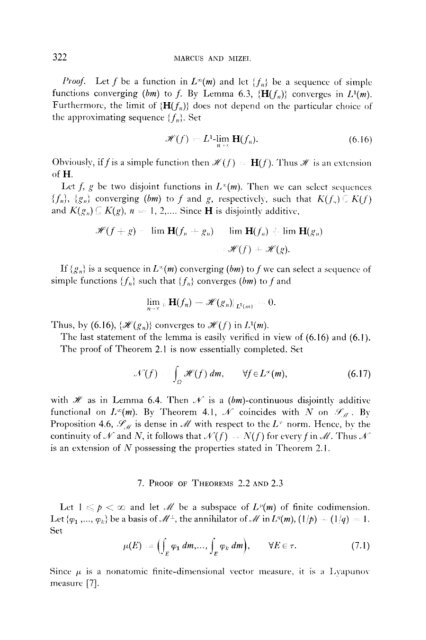Extension Theorems of Hahn-Banach Type for Nonlinear Disjointly ...
Extension Theorems of Hahn-Banach Type for Nonlinear Disjointly ...
Extension Theorems of Hahn-Banach Type for Nonlinear Disjointly ...
You also want an ePaper? Increase the reach of your titles
YUMPU automatically turns print PDFs into web optimized ePapers that Google loves.
322 MARCITS AND MIZEI.<br />
I’roqf. Let f be a function in La(m) and let (f,J be a sequence <strong>of</strong> simple<br />
functions converging (om) to f. By Lemma 6.3 , [H(f,,)J con\:ergcs in Z,‘(~z).<br />
Furthermore, the limit <strong>of</strong> [H(fJ) c 1 oes not depend on the particular choice <strong>of</strong><br />
the approximating sequence (fni. Set<br />
X(f) L’-‘,)I; H(f;,). (6.16)<br />
Ohviousl~-, iff is a simple function then &‘(,f) H( /‘). ‘l’hus .A’ is an extension<br />
<strong>of</strong> H.<br />
Let f, ‘y be two disjoint functions in I,~(nz). Then we can select sequences<br />
{fn>, {slli converging (6~2) to f and R, respectivcl!,, such that K(f,,) m’- K(,f)<br />
and K(R,!) c-1 k-(g), ?z 1, 2,.... Since H is disjointly additive,<br />
.m(.f 7~ R) lirn H(.f,, I- ,T,,) lim H(f,,) lim H(g,,)<br />
,X(f) ! AQ).<br />
If (:,,I is a sequence in L--(m) converging (bm) t<strong>of</strong> we can select a sequence <strong>of</strong><br />
simple functions (.f,l. such that {fn) converges (6~) to .f and<br />
!,ll_lj JXfn) -- Wx’n); L,(,,,) 0.<br />
Thus, by (6.16), [X(gJ) converges to %(,f‘) in l,l(m).<br />
The last statement <strong>of</strong> the lemma is easily verified in view <strong>of</strong> (6.16) and (6. I ).<br />
The pro<strong>of</strong> <strong>of</strong> Theorem 2. I is now essentially completed. Set<br />
%,4’(f) I . X’(f) dm, Vf’fELn(m), (6.17)<br />
-5?<br />
with It// as in Lemma 6.4. Then -4’ is a (bm)-continuous disjointly additive<br />
functional on I,=(m). By Theorem 4. I, .Af coincides with N on - .‘f(( By<br />
Proposition 4.6, Cyjfl is dense in A’ with respect to the I,’ norm. Hence, by the<br />
continuity <strong>of</strong> ,Y- and N, it follows that A”(,f) Al’ <strong>for</strong> everyf in A’. Thus .A”<br />
is an cstcnsion <strong>of</strong> IV possessing the properties stated in Theorem 2.1.<br />
7. PROOF OF THEOREMS 2.2 AND 2.3<br />
Let 1 --: p < c/u and let :A’ be a subspace <strong>of</strong> L”(m) <strong>of</strong> finite codimension.<br />
Let (v, ,..., F,() be a basis <strong>of</strong> ML, the annihilator <strong>of</strong> A! in Z,“(m), (I !p) (1 /q) 1.<br />
Set<br />
p(E) -: (.lE y, dm ,..., lE v,$. dm), V’B t 7. (7.1)<br />
Since p is a nonatomic finite-dimensional vector measure. it is ;I I,yapuno\-<br />
measure [7].

















